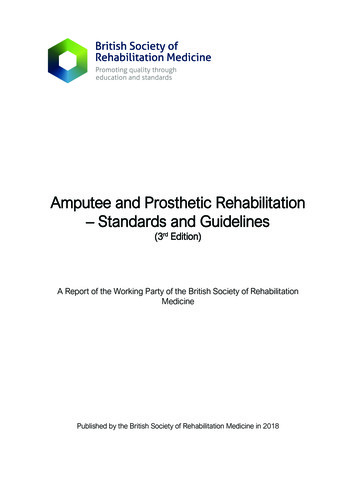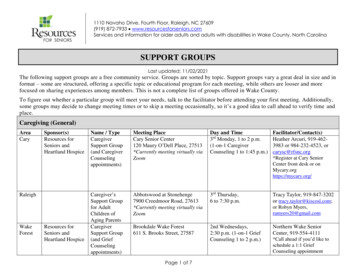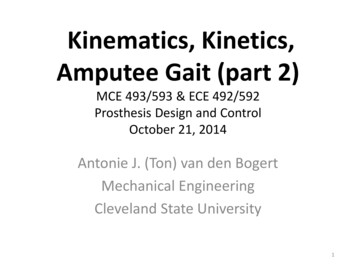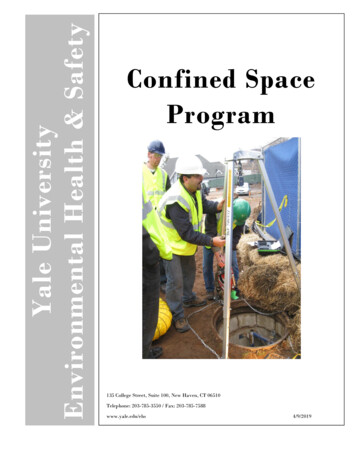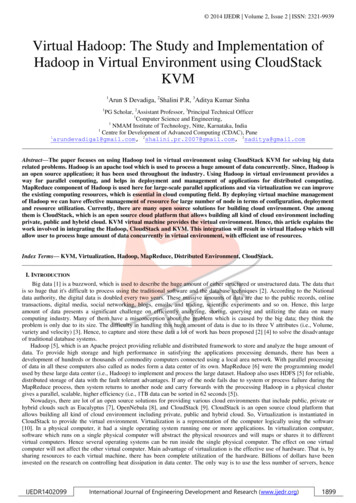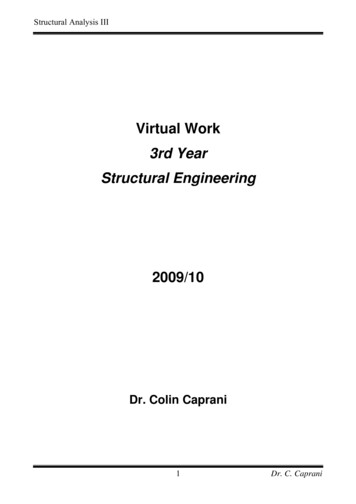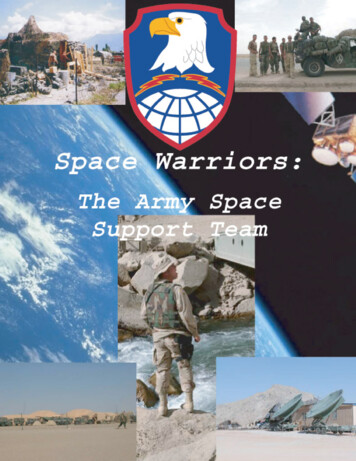
Transcription
Amputee Virtual Environment Support Space— A vision for virtual military amputee supportThe war in Iraq is the largest and longest sustained combat operation bythe U.S. military since the Vietnam war. An estimated nearly 2 million U.S.military personnel have been deploye d for Operation Iraqi Freedom andOperation Enduring Freedom [1]. Dr . C huck Scoville, Col. Ret., Chief ofAmputee Patient Care at Walter Reed Army Medical Center, stated that as ofNovember 2009, 937 war fighters have suffered an amputation as a result ofa battle injury. The successful recovery from a traumatic injury resulting inan amputation lar gely depends on care fr om clinical prov iders as well aspeer support.CURRENT AMPUTEE CARE—STAGES OF RECOVERYAs outlined by Berke, foll owing amputation, five st ages of care occur ,during which an amputee interacts with clinical providers [2] ( Table 1 ).Although the current standard of amputation care mainly focuses on healingthe physical wounds and returning the patient to a desirable functional level,more attention needs be focused on th e psychological needs and social/peersupport.Doug Thompson; Ashley Fisher, MAAs discussed by Hashemi et al., afte r the initial trauma from an amputation, patients commonly experience de nial, anger , depression, disconnec tion, disempowerment, and vulnerability [3]. These feelings usually producea sense of pragmatic acceptance tha t life will be dif ferent fo r them. Ifpatients recover psychologi cally and realize that th ings could have beenworse, they are considered to be on the path toward a cceptance with resil ience. However, if they do not recove r from their mental wounds, they fallinto acceptance with resignation. At this stage, patients might feel abnormaland suffer from depression. This generally occurs because of a lack of socialsupport, a severe physical condition, and/or poverty.Table 1.Stages of surgery and recovery.StageName1Preoperative2Acute hospital postoperative environment3Intermediate postacute hospital45Intermediate recoveryTransition to stableviiDurationImmediately5 to 14 daysDescriptionDecision to amputate or salvage limbWound healing4 to 8 weeksEarly rehabilitationPreliminary prosthetic fittingFurther rehabilitationRelative stabilization of residual limb4 to 6 months12 to 18 months
viiiJRRD, Volume 47, Number 6, 2010SOCIAL AND PEER SUPPORTPhysical rehabilitation alone is not sufficient fora ful l recovery . A ful l recovery from limb lossrequires deep psychological and social support thatincludes patience, tenacity , and help from friends,family, and the community [4]. Peer support poten tially can provide inform ation and education notachieved in any other te am relationship. V ariousaspects of peer support, such as peer visitation,amputee support groups, and consumer awareness,have all been proven useful resources [2].The literature suggests th at peer support has beena salien t factor in the s uccessful recovery of ampu tees. In a study of land mine survivors who underwentamputations, Sperber-Richie et al. report descriptionsfrom landmine survivors from various countries onthe impact of family and community on their recovery[4]. They found that the in teraction with other survi vors provided a peer support network that empoweredthem to persevere despite their injuries. One survivorattributed the ongoing visits from other amputees asthe first step in drawing himself out of a severe mentalcrisis. Many of the newer amputees found that seeingother recovered soldiers inte grated back into societywas helpful.VIRTUAL WORLDSThe Internet has the pote ntial to greatly af fectthe social bonds a nd indepe ndence of people withvarious disabilities. A Harris Poll in 2000 found thatpeople with disabilities were less likely to be onlinethan those without disabilities (43% and 57%,spentrespectively), but those who did go onlinetwice as much time online as those without disabili ties [5]. Since this poll was conducted, the advent ofWeb 2.0 in 2004 has stimulated new opportunitieson the W orld W ide W eb (WWW). Gorini et al.write, “The introduction of Web 2.0 has facilitatedthe development of new forms of collaborativeinteraction between multiple users based on 3-D[three-dimensional] virtua l worlds” [6]. These vir tual world interactions far exceed historical WWWcapabilities such as emails , chat rooms, and videoconferences. In short, a virtual world is a 3-D simulated enviro nment accesse d thro ugh a commercialInternet connection [6–7].In these virtual worlds , people appear as ava tars, which are computer users’ 3-D self-representations [8]. Through their avatars, users create a senseof personal space, as well as the virtual representa tions of themselves. V irtual-reality environmentsare social s paces that us e special platforms to meetthe needs of the people who come together . Theycan provide a sense ofbelonging—the sense ofbeing in th e s ame pl ace and doing the samethings—for people who have an increasing desire togather with friends via the network. Second Life,established in 2003, is curr ently one of the mostpopular and successful virt ual environments [9].Now known as Second Life Enterprises, it is one ofthe lar gest virtual world communities, with nearly13 million users around the world.Many lar ge or ganizations have already startedembracing virtual worlds a nd use them for a multi tude of applications, in cluding circulating healthinformation and hosting discussion forums, educa tional lectures, and virtual visualizations of upcoming building projects [10]. Table 2 lists samp leprojects that employ these virtual worlds.VIRTUAL WORLD SUPPORT GROUP FORMILITARY AMPUTEESAs mentioned, peer support is a salient factor inthe recovery of combat -wounded amputees. Whilein the hospital setting, amputee war fighters areoften surrounded by their peers and can readily findsupport in their fellow servicemen and -women. Asthey move through the sy stem of care and findthemselves back in the home setting, alternative andaccessible options for c ontinued peer support areimportant. The virtual world potentially providesthis platform for a peer support group for amputees.In the virtual world envi ronment, no set timeexists for engaging in peer support. In fact, onecould sign on at any time, day or night, and likelyfind someone to whom they can talk. The virtualworld als o p rovides ano nymity b ecause u sers are
ixTHOMPSON and FISHER. Guest EditorialTable 2.Current applications of virtual worlds.OrganizationPurposeCenters for Disease ControlCirculate health information in form of online media and podcasts.Provide virtual microscopes in virtual laboratories to educate.Host health fairs.American Cancer SocietyProvide virtual lectures and support groups.Britain’s National Health ServiceEducate and help students prepare for medical school [1].University of IllinoisEducate and help students prepare for medical school [1].Palomar Pomerado HealthSet up a virtual hospital to allow future residents to experience new building before construction completion [2].U.S. Army Training and DoctrineCommandExplore capabilities for potential strategic messaging, networking, collaborations, training, and education [3].Create Second Life venue for Wounded Warrior Education Fair.Initiate classroom in Active Worlds for Army and interagency partners.Recruit future soldiers as part of the Future Soldier Training Program by having virtual recruiters, drill sergeants, and soldiers who have recently completed initial entry training.1. Bruck L. Second Life: Test-driving real-world innovations. Hosp Health Netw. 2008;82(10):50–54. [PMID: 19031844]2. Solovy A. Get a [Second] Life: Powerful virtual world is transforming health care in ways that astound and inspire [Internet]. Chicago (IL): Hospitals & HealthNetworks; 2008. Available from: http://www.hhnmag.com/hhnmag app/jsp/articledisplay.jsp?dcrpath HHNMAG/Article/data/ 08AUG2008/0808HHN BusMatters&domain HHNMAG3. Army Exploring Virtual Worlds [Internet]. Washington (DC): Department of the U.S. Army; 2008 [2008 Nov 21; cited 20 10 Jan 9 ]. Available from: ipped of their physical identity and, in some cases,their disabilities [11]. For example, Nomav, a tetra plegic with a rare form of muscular dystrophy , isinvolved in a Second Life support group environ ment. While he cannot brea the without a ventilatorin real life, he can walk, dance, and even fly in Sec ond Life [12]. Gorini et al . note that vi rtual worldsprovide a greater feeling of presence among the avatars than one might expe rience in a disembodiedchat room [6]. This presence makes the clinical communication process easier to facilitate, positivelyinfluences group processes, and provides cohesive ness in group-based ther apies. In S econd Life,amputees co uld participate in live lectures to learnabout new rehabilitation tec hniques or prostheses orfor other educati onal purposes. Th ey could alsobrowse similarly themed document collections in thevirtual environment in their spare time. Most importantly, the amputee war fi ghters would be able toreconnect with individuals who have fought similarbattles, both on the physical and psychologicalfronts.AMPUTEE VIRTUAL ENVIRONMENT SUPPORT SPACE FOR MILITARY VETERANS WITH AMPUTATIONSBased on all the potential benefits of virtualpeer support for military amputees, the T elemedicine and Advanced T echnology Research Center(TATRC, Fort Detrick, Maryland), in partnershipwith ADL Company (Bloomington, Minnesota) andVirtual Ability, Inc (Aurora, Colorado), set out tocreate a s uccessful virtu al island for amputee peersupport groups.In September 2009, the Amputee V irtual Environment Support Sp ace (AVESS) two-phase devel opment program was launche d. Durin g the initialphase, planning sessions, advisory panel discus sions, hardware/software de monstrations (i.e., thefunctionality of the Sec ond Life Enterprise), andconcept demonstrations were performed to assessthe benefits and functionality of the virtual environment for military amputee peer-to-peer and familysupport. The advisory pa nel members included anactive Second Life military amputee, the spouse of
xJRRD, Volume 47, Number 6, 2010an injured Army veteran, an Army amputee athlete,a disabled military pe rsonnel peer support groupleader, and an amputee leader from the Departmentof Veterans Affairs and Department of Defense.The second phase of th e AVESS developmentwill focus on the construction of the AVESS environment, as well as human-use studies to determine theTheefficacy of the online peer support groups.AVESS environment will be deployed on SecondLife Enterprise, a stand-al one server cluster thatADL Company will host for the duration of theproject and that will be acces sible from T ATRC’sSecond Life laboratory to re view real-time progress.The AVESS environment consists of four main vir tual environment regions (Figure). The AVESS environment includes a number of regions, as shown inthe Figure. The overall island ( Figure (a)) includesthe orientation region (Figure (b)), where users learnhow to navigate and are in troduced to the immersiveenvironment; the meeting region (Figure (c)), whichallows private group meeti ngs among users; and theavatar customization area ( Figure (d)), where userscan change their avatars to express their identity inthe virtual space.CONCLUSIONSThe AVESS program continues to research thepeer support needs of mili tary amputees and estab lish protocols and prototypes for addressing theseneeds and supplementing pr e-existing peer -to-peerand family support with other online and telemedi cine resources.Doug Thompson;1* Ashley Fisher, MA21ADL Company, Remedy Communications, Bloomington, MN; 2Battelle Memorial Institute, Columbus,OH, and Advanced Prosthetics and Human Performance Portfolio, Telemedicine and AdvancedTechnology Research Center, U.S. Army MedicalResearch and Materiel Command, Frederick, MD*Email: doug@adlcompany.comFigure.(a) Amputee V irtual Envi ronment Support Space, (b) o rientationregion, (c) small group meeting region, and (d) avatar customizationregion.
xiTHOMPSON and FISHER. Guest EditorialREFERENCES1. Peterson AL, Baker MT , McCarthy KR. Combatstress casualties in Iraq. Part 1: Behavioral he althconsultation at an expeditionary medical group.Perspect Psychiatr Care. 2008;44(3):146–58. [PMID: 18577120] DOI:10.1111/j.1744-6163.2008.00169.x2. Berke G. Standards of care. J Prosthet Orthot. 2004;16:6. DOI:10.1097/00008526-200407001-000033. Hashemi B, Shaw RJ, Hong DS, Hall R, Nelson K,Steiner H. Post traumatic stress di sorder foll owingtraumatic injury: Narratives as unco nscious in dicators of psychopathology. Bull Menninger Clin. 2008;72(3):179–90. [PMID: 18990054] DOI:10.1521/bumc.2008.72.3.1794. Sperber-Richie B, Ferguson A, Adamaly Z, ElKhoury D, Gomez MJ. Paths to recove ry: Coordinated an d co mprehensive care for landmine survivors. J Mine Action. 2002;63:66–69.5. Miller SM. The ef fects of freque ncy and type ofInternet use on perceived social support and senseof well-being in individuals with spinal cord injury.Rehabil Couns Bull. 2008;51(3):148–58. DOI:10.1177/00343552073113156. Gorini A, Gaggioli A, V igna C, Riva G . A sec ondlife for eHealth: Prospects for the use of 3-D virtualworlds in clinical psycho logy. J Med Intern et Res.2008;10(3):e21. [PMID: 18678557] DOI:10.2196/jmir.10297. Army Exploring Virtual Worlds [Internet]. Washington (DC): Department of th e U.S. Army; 20 08[2008 Nov 21; cited 2 010 Jan 9]. A vailable 1/8. Solovy A. Get a [Second] Life: Powerful virtualworld is tran sforming heal th care in ways thatastound and inspire [Internet]. Chicago (IL): Hospitals & Health Networks; 2008. Available from: http://www.hhnmag.com/hhnmag app/jsp/ articledisplay.jsp?dcrpath HHNMAG/Article/data/08AUG2008/0808HHN BusMatters&domain HHNMAG9. Bruck L. Second Life: Test-driving real-world innovations. Hosp Health Netw. 2008;82(10):50–54. [PMID: 19031844]10. Howard CE. U.S. intelligence community invests inForterra to accelerat e virt ual military training[Internet]. Tulsa, (OK): PennWell: 2007 Dec [2 Feb2010]. 1 p. Available from: http://www. militaryaerospace.com/index/display/article- display/315298/articles/military-aerospace- electronics/volume-18/issue-12/news/news/ celerate-virtual-military-training.html11. McKenna KY, Green AS. Virtual group dynamics.Group Dyn. 2002;6(1):116–27. DOI:10.1037/1089-2699.6.1.11612. Avitzur O. Getting a Second Life—In an onlinehealth community [Intern et]. W ashington (DC):Consumer Reports; 20 08 [up dated 2 008 Ju n 4 ;cited 2010 Jan 11]. Available from: nding-an-onli.htmlThis article and any supplementary material should be citedas follows:Thompson D, Fisher A. Amputee Virtual EnvironmentSupport Space—A vision fo r virtual military amputeesupport. J Rehabil Res Dev. 2010;47(6):vii–xii. DOI:10.1682/JRRD.2010.04.0071
sions, hardware/software demonstrations (i.e., the functionality of the Second Life Enterprise), and concept demonstrations were performed to assess the benefits and functionality of the virtual environ-ment for military amputee peer-to-peer and family support. The advisory panel members included an
